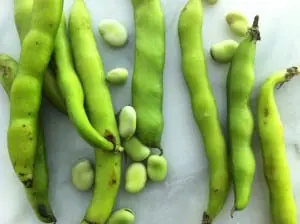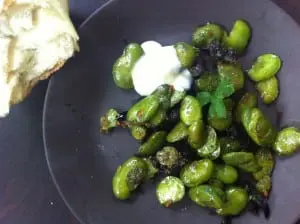By Celia Barbour
Every decision requires a trade-off.
Five years ago, when we decided to move from Manhattan to Garrison, we figured we were giving up sidewalks, Malaysian takeout and fresh fava beans from the market in exchange for grassy fields where the kids could play, air we would actually enjoy breathing and a bang-up community.
 Turns out, we were right about everything but the fava beans. Our second spring here, I stopped in one morning at Vera’s — a store whose sole fault is its inconvenient distance from our house — and discovered a small pile of the big pods. I was bowled over. I bought every last one.
Turns out, we were right about everything but the fava beans. Our second spring here, I stopped in one morning at Vera’s — a store whose sole fault is its inconvenient distance from our house — and discovered a small pile of the big pods. I was bowled over. I bought every last one.
My joy was not unadulterated, however. Truth be told, I am someone who likes to nurse a grouse. And complaining about the lack of fresh shell beans in Garrison had been one way for me to keep alive the sense that my family’s move northward had wronged me somehow, coming as it did at no small cost to my culinary self. In other words, this discovery of fava beans at Vera’s was like telling a raging hypochondriac that he’s in perfect health: Great news that leaves the recipient feeling slightly deflated inside. Like: What do I do now?
In the short term, that question was easy to answer. Fava beans take a lot of work to prepare, because nature has double-wrapped them in both a pod and a membrane, both of which interfere with one’s enjoyment of the bean. To remove the beans from their pods, you twist the latter until they crack, then pluck out the beans. To liberate the beans from their tough membrane, you dump them in boiling water then shock them in very cold water, after which it is not hard to tear open the membrane with your fingernails and squeeze out the slippery, lime-green bean. It is now — only now — ready to be cooked (though the tiny ones can be eaten as is, a nice reward for your efforts).
 The work is not at all difficult, and is in fact the kind of meditative task to which helpful kids and contemplative moms might enjoy devoting a half hour (This is often true of cooking: Many processes that have a reputation for being difficult are merely time-consuming). But it eats up enough of an afternoon to make the resultant beans feel fairly precious.
The work is not at all difficult, and is in fact the kind of meditative task to which helpful kids and contemplative moms might enjoy devoting a half hour (This is often true of cooking: Many processes that have a reputation for being difficult are merely time-consuming). But it eats up enough of an afternoon to make the resultant beans feel fairly precious.
I was not aware of how laborious fava beans were the first time I tried them in a restaurant. I only knew that they tasted amazing — smoother and slipperier than other beans, with a fresh, grassy-sharp flavor that seemed like some compressed nugget of springtime. That alone would have been enough to make me order them every time I saw them on a menu. But once I’d tried cooking them myself, I felt an extra kind of princessy satisfaction in knowing that some ambitious young line cook was dues-paying his way through pod and membrane-removal for my sake. I ate them in salads with escarole and pecorino (a wonderful combination), in bacon-y pasta dishes, stewed with morels and asparagus, alongside grilled meats and on canapés.
In my own kitchen, I sought a recipe that was worth the effort, and after many delicious experiments, landed on the one below, an adaptation of something I tasted many years ago in Los Angeles. I like to make it for great friends, the kind of excellent people who, it turns out, are a dime a dozen in this neck of the woods.
Fava beans, olive and parsley salad with feta dip
Serve this with sliced baguette or a crusty Italian loaf
For the salad
2 pounds fava beans, in their pods
4 ounces oil-cured black olives
1 small bunch flat-leaf parsley, torn
1 tablespoon lemon juice
zest of ½ lemon
2 tablespoons olive oil
2 sprigs rosemary
pinch cayenne
¼ teaspoon New Mexican chile powder or one small dried mild chile
1 clove garlic, minced
Salt and pepper
For the dip
1/3-pound feta cheese
1 tablespoon olive oil
1 tablespoon lemon juice
Zest of ½ lemon
- Make an ice bath (or just fill a large bowl with really cold water). Bring a pot of salted water to a boil. Meanwhile, remove the beans from their pods. When the water boils, add the beans and blanch them for about 2-3 minutes. Drain quickly and plunge them into the ice-cold water. When they are cool, tear open the membranes and pop out the beans.
- Pit the olives by pressing firmly top to bottom until they split and separate from the pit. Tear into small pieces. In a bowl, combine the olive pieces with the parsley, half of the lemon zest and a teaspoon of the lemon juice.
- Heat a skillet over low heat. Add the olive oil, and when it is warm, add the rosemary, cayenne, chile and minced garlic. Sauté for two minutes, then add the fava beans and a sprinkling of salt and pepper, and turn up the heat to medium-low. Cook, stirring occasionally, until the beans begin to look a little blistered and coppery on the outside and are tender all the way through.
- Meanwhile, make the dip: Place the feta cheese and the other three ingredients in a blender and puree until smooth.
- When the fava beans are done, transfer them to the bowl with the olive-parsley mixture. Toss gently to combine. Taste and correct the seasoning. Serve at room temperature with sliced baguette and the feta dip alongside.

